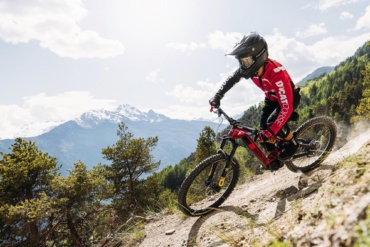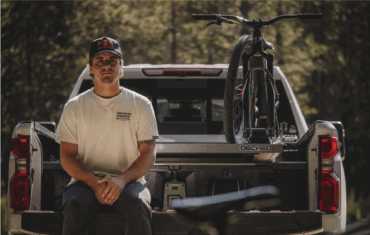For road or trail, the easy-to-hitch, single-wheel Burley Coho XC bicycle trailer takes loads your panniers can’t handle.
If you’ve ever used a bike trailer, you know the most annoying parts of the process are hitching up and un-hitching it from the bike. If you haven’t — just trust me on this one. Burley has come up with a brilliant one-handed connect-and-release design that will make you completely indifferent to the process.
Literally at the hub of this system are the Burley Ballz axle connectors. Just like it sounds, Burley provides axle connections with a black ball on either side of the rear axle by either a quick-release axle, thru-axle, or nutted axle ends. The trailer hitch yoke is adjustable to accommodate axle widths from 125 to 197 mm.
Burley Coho XC: Why a Bike Trailer?
Burley designed the Coho XC (“cross-country”) for bikepacking. As a single-wheel trailer, it’s much more nimble and stable (at speed) than a two-wheeled trailer. The one wheel is in line with the wheels on your bike. And except for very sharp turns, that single wheel will follow the line you pick through roots and rocks for yourself on your bike.
With two-wheeled trailers, those side-by-side wheels stick out and are prone to catching an unwanted bump or even a small tree. A big enough bump will even put the trailer on its side — as I did while hauling my 2-year-old in such a trailer. She was safely strapped in, a little spooked, but a real trooper. She had a great recovery.
Bikepacking-Specific Trailer
The other feature specific to supporting taking the Coho XC on trails is the built-in suspension for its one wheel. Burley has been making suspension systems for its two-wheeled trailers for some time, and the brand has applied all it has learned to the Coho XC.
The coil-spring suspension can take up to a 70-pound load and still provide some give for rougher trails. Also for those rougher trails, Burley makes a plus-size 3-inch-wide tire for an extra $89.
There are a few other reasons trailers, in general, are a great choice for bikepacking. First, the weight of the gear is not on the frame of the bike; it’s split between the rear axle and the trailer wheel.
With panniers, all the weight of the bike is hanging from some part of the frame. That then requires a beefier (ergo heavier) bike, adding more weight, which is just what most bikepackers (or bike tourers) are trying to avoid.
Another disadvantage of panniers is that they split your gear up into numerous compartments. This forces the user to remember where they packed their gear. If it’s necessary to remove the panniers each night, then the user is stuck carrying a bunch of bags.
With the trailer, you can pack almost everything into the one bag that sits in the trailer (which Burley makes as an $89 add-on).
Many of the above features are not unique to the Coho XC. There are a few other single-wheel bike trailers with suspension out there. And, like a few other trailers, you can disassemble and break down the Coho XC without tools. Pack it away for airplane travel if your bikepacking adventure is a little farther-flung.
But features like the one-handed quick-release handle to unhitch the trailer from the bike would be hard to find elsewhere. Once the trailer is un-hitched, the wide kickstand will hold the trailer upright. With a light enough bike, it will hold the bike up as well when attached.
The Coho XC trailer’s frame and the fender over the wheel are level to accommodate strapping on items longer than the trailer itself. This is another advantage to its clever design.
Burley Coho XC Bike Trailer in Town
Beyond bikepacking, the Coho XC has also proven to be extremely useful around our household over the past year of testing. Because it’s hitched to the rear axle instead of the seat post like some, I can still have a kid seat attached.
So if I’m riding around town with my kid, I can still take some things along. This is a much more comfortable way for the kid to travel instead of just wearing a backpack that often is right in their face. Also, panniers aren’t usually an option with a kid seat attached, as the rear rack and kid seat often interfere with each other.
For me, one specific use of the Coho XC with kids has been when I pick up my older child from preschool. I can fit her 16-inch bike in the Coho XC along with bags of snacks and picnic supplies and have my son in the kid seat.
On our way home from preschool, we hit the neighborhood playground, and the two of them get their wiggles out and still have a nice place to stop for a snack and drink. It has also been great for hauling loads of goodies home from our local farmer’s market 3 miles from our house. Parking there can be tough, so it’s much nicer to ride versus drive.
For the brave souls willing to ride in the winter and haul things, the aforementioned plus-size tire has a knobby tread to help stabilize the trailer in the snow.
The Nitty-Gritty
Over the past year and hundreds of miles of testing, I got into the nooks and crannies of the trailer. The tough nylon side panel fabric is easy to remove and reattach on the lightweight aluminum frame.
The accessory attachment points provide a place to install one or two bottle cages or a pannier rack ($59), sold separately. Burley sells panniers sized to fit for $89.
The trailer itself is beefy and weighs 21 pounds, which is its biggest downfall. But that’s in part because Burley made the Coho XC for use on trails. Most other trailers are only capable of road use.
The cargo box measures 24 x 15 x 11.5 inches, or 70 L in volume. This works for most long-weekend bikepacking trips. Plus, you can strap on even more thanks to the rounded frame bars and the included cargo cover net.
You can get one now for $450.








